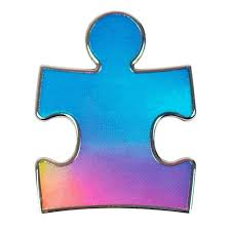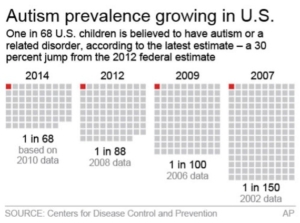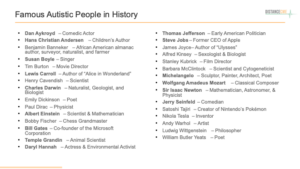ASD-If you meet just one person on the Autism Spectrum, you’ve met only one person on the Autism Spectrum
Donald Gray Triplett. (Born September 8, 1933, Forest, Mississippi, U.S.—died June 15, 2023, Forest, Mississippi), American male who was the first person diagnosed with autism. His parents, unable to cope with some of his developmental delays, committed him to a state institution in 1937. They withdrew him a year later. Triplett attended the local high school, where his disabilities were largely accepted, and in 1958 he received a bachelor’s degree in French from Millsaps College in Jackson, Mississippi.
In October 1938 Triplett was examined by Austrian child psychiatrist Leo Kanner at Johns Hopkins Hospital in Baltimore, Maryland. In 1943 he published an article titled “Autistic Disturbances of Affective Contact” that outlined the basic symptoms of the disorder later known as autism.
Autism spectrum disorder (ASD) is a neurological and developmental disorder that affects how people interact with others, communicate, learn, and behave. Although autism can be diagnosed at any age, it is described as a “developmental disorder” because symptoms generally appear in the first 2 years of life. In 2023, the CDC reported that approximately 1 in 36 children in the U.S. is diagnosed with an autism spectrum disorder (ASD), according to 2020 data. Drowning remains a leading cause of death for children with autism and accounts for approximately 90 percent of deaths associated with wandering or bolting by those age 14 and younger.
ASD is not increasing; the medical community is getting better at diagnosing. Previously children were considered “deaf and dumb” or “mentally retarded”. 44% have IQ scores in the average to above average range (i.e., IQ >85). We know that there’s no one cause of autism. Research suggests that autism develops from a combination of genetic and nongenetic, or environmental, influence. There are various theories, however, over the last two decades, extensive research has asked whether there is any link between childhood vaccinations and autism. The results of this research are clear: Vaccines do not cause autism.
Social communication challenges
Children and adults with autism have difficulty with verbal and non-verbal communication. For example, they may not understand or appropriately use:
- Spoken language (around a third of people with autism are nonverbal)
- Gestures
- Eye contact
- Facial expressions
- Tone of voice
- Expressions not meant to be taken literally.
Additional social challenges can include difficulty with:
- Recognizing emotions and intentions in others
- Recognizing one’s own emotions.
- Expressing emotions
- Seeking emotional comfort from others
- Feeling overwhelmed in social situations
- Taking turns in conversation
- Gauging personal space (appropriate distance between people)
Restricted and repetitive behaviors
Restricted and repetitive behaviors vary greatly across the autism spectrum. They can include:
- Repetitive body movements (e.g. rocking, flapping, spinning, running back and forth)
- Repetitive motions with objects (e.g. spinning wheels, shaking sticks, flipping levers)
- Staring at lights or spinning objects
- Ritualistic behaviors (e.g. lining up objects, repeatedly touching objects in a set order)
- Narrow or extreme interests in specific topics
- Need for unvarying routine/resistance to change (e.g. same daily schedule, meal menu, clothes, route to school)
Dr. Temple Grandin was not formally diagnosed with autism until her adulthood. When she was two, the only formal diagnosis given to her was “brain damage” and the medical advice at the time for a diagnosis of autism was to recommend institutionalization. Grandin considers herself fortunate to have had supportive mentors from elementary school onward. Even so, Grandin states that junior high and high school were the most unpleasant times of her life. Grandin went on to earn her bachelor’s degree in human psychology from Franklin Pierce College in 1970, a master’s degree in animal science from Arizona State University in 1975, and a doctoral degree in animal science from the University of Illinois at Urbana–Champaign in 1989. Grandin is a prominent and widely cited proponent for the humane treatment of livestock for slaughter. She is internationally famous as a spokesperson on autism, as well.
 The puzzle piece-originally used by the National Autism Society in the UK in 1963 to represent autism spectrum disorder. The interlocking pieces represent the unknowns of autism. The different colors of the puzzle pieces represent the vast diversity of the autism spectrum.
The puzzle piece-originally used by the National Autism Society in the UK in 1963 to represent autism spectrum disorder. The interlocking pieces represent the unknowns of autism. The different colors of the puzzle pieces represent the vast diversity of the autism spectrum.
ASD-Blatt, Gene. “autism”. Encyclopedia Britannica, 28 Jun. 2023, https://www.britannica.com/science/autism.
Temple Grandin. (2023, June 22). In Wikipedia.
https://en.wikipedia.org/wiki/Temple_Grandin
Autism Speaks
Temple Grandin website
https://www.templegrandin.com/



